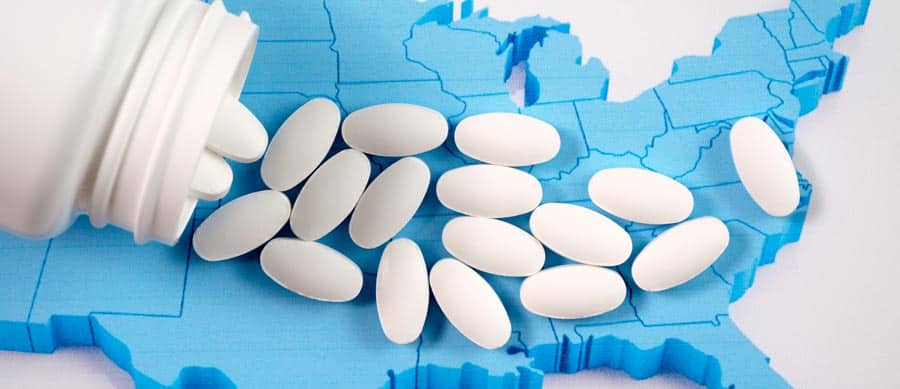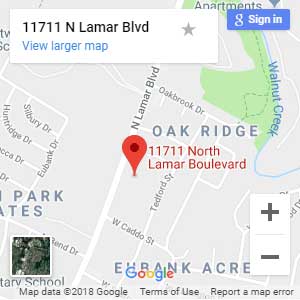Updated on August 10th, 2020
About 64,000 Americans (or 174 people each day) died from drug overdose in 2016. This is more lives than were claimed by gun-related homicides and car accidents.7 Although many overdose deaths involve multiple drugs, the majority of these overdoses are caused by opioid drugs like heroin and fentanyl, and the rampant over-prescription of opioid medications in the U.S. also plays a big part in this.8
Table of contents
While the entire country has suffered, several states have seen the worst of it, with much higher than average rates of death from opioid overdoses. Here’s a look at some of the most recent data available on opioid overdose deaths and opioid prescribing practices in America.
Rates of Death from Opioid Overdoses
- U.S. opioid overdose deaths in 2015 were highest in:
- West Virginia1
- Ohio1
- Kentucky1
- Pennsylvania1
- Nationwide rate of deaths from opioid overdoses in 2015 was about 10 per 100,000 people.1
- Pennsylvania’s was about 10.5 per 100,000 people.1
- Kentucky’s was about 20 per 100,000 people.1
- Ohio’s was about 22 per 100,000 people.1
- West Virginia’s was 35 per 100,000 people.1
- In 2017, suspected opioid overdoses (per 10,000 emergency department visits) were highest in the northeastern states, followed by the midwestern and western states.6
States in the southwest region of the U.S. had the lowest number of suspected opioid overdoses in 2017 (per 10,000 emergency department visits).6
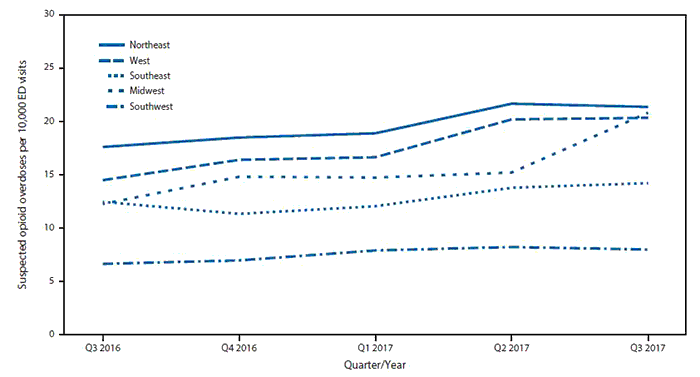
Drug Overdose Death Rates by State (primarily driven by opioids)
- In 2018, there were more than 67,367 drug overdose deaths in the United States, a 4.1% decline from 2017 (70,237 deaths).2
- The rate of drug overdose deaths involving synthetic opioids other than methadone (drugs such as fentanyl, fentanyl analogs, and tramadol) increased by 10%, from 9.0 in 2017 to 9.9 in 2018.2
- From 2012 to 2018, the rate of drug overdose deaths involving cocaine increased by more than three times (from 1.4 to 4.5) and the rate for deaths involving psychostimulants like meth increased nearly 5-fold (from 0.8 to 3.9).2
- The national U.S. drug overdose death rate in 2018 was 20.7 per 100,000 people.2
- The states with the highest drug overdose death rates in 2018 were:
- West Virginia (51.5 per 100,000)2
- Delaware (43.8 per 100,000)2
- Maryland (37.2 per 100,000)2
- Pennsylvania (36.1 per 100,000)2
- Ohio (35.9 per 100,000)2
- New Hampshire (35.8 per 100,000)2
- The states with the lowest drug overdose death rates in 2018 were:
- Texas (10.4 per 100,000)2
- North Dakota (10.2 per 100,000)2
- Iowa (9.6 per 100,000)2
- Nebraska (7.4 per 100,000)2
- South Dakota (6.9 per 100,000)2
- In 2016, the drugs most commonly involved in U.S. overdoses were:
- Synthetic opioids (not including methadone) – 20,145 overdoses3
- Heroin – 15,446 overdoses3
- Natural and semi-synthetic opioids -14,427 overdoses3
- Cocaine – 10,619 overdoses3
- Methamphetamine – 7,663 overdoses3
- Methadone – 3,314 overdoses3
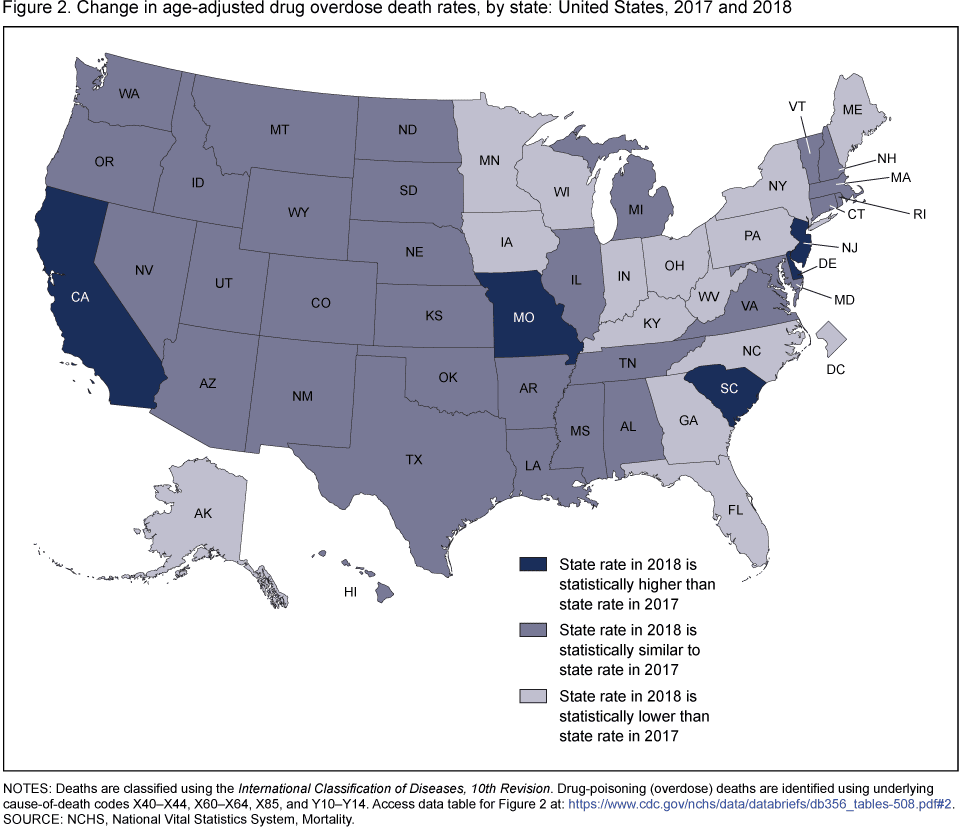
Opioid Prescribing Rates
- In 2012, healthcare providers in the highest-prescribing state wrote almost 3 times as many opioid prescriptions per person as those in the lowest prescribing state.4
-
- In 2018, the states with the most opioid prescriptions per 100 people were:4
- Alabama
- Arkansas
- Indiana
- Mississippi
- Louisiana
- Tennessee
- Kentucky
- West Virginia
- South Carolina
- Oklahoma
- Kansas
**These states all had 64.1-107.1 opioid prescriptions per 100 people
- In 2018, the states with the most opioid prescriptions per 100 people were:4
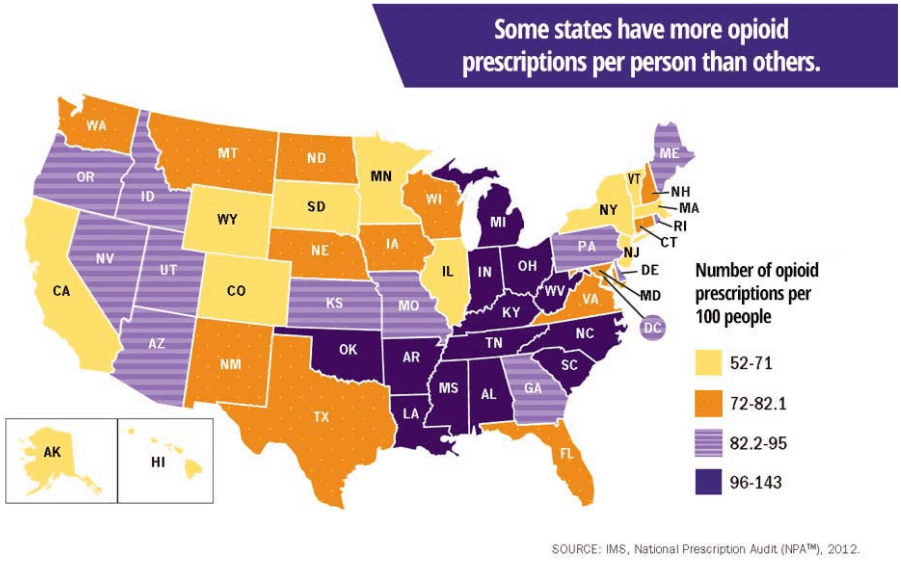
Nationwide Opioid Prescribing Rates
- In 2018, the overall national opioid prescribing rate had fallen to the lowest it had been in 13 years at 51.4 prescriptions per 100 persons (more than 168 million total opioid prescriptions).5
- In 11% of U.S. counties, enough opioid prescriptions were dispensed for every person to have one. (2018)5
- The overall opioid prescribing rate in 2018 was 51.4 prescriptions per 100 people, some counties had rates that were six times higher than that.5
While the overall opioid prescribing rate in 2016 was 66.5 prescriptions per 100 people, some counties had rates that were seven times higher than that.5
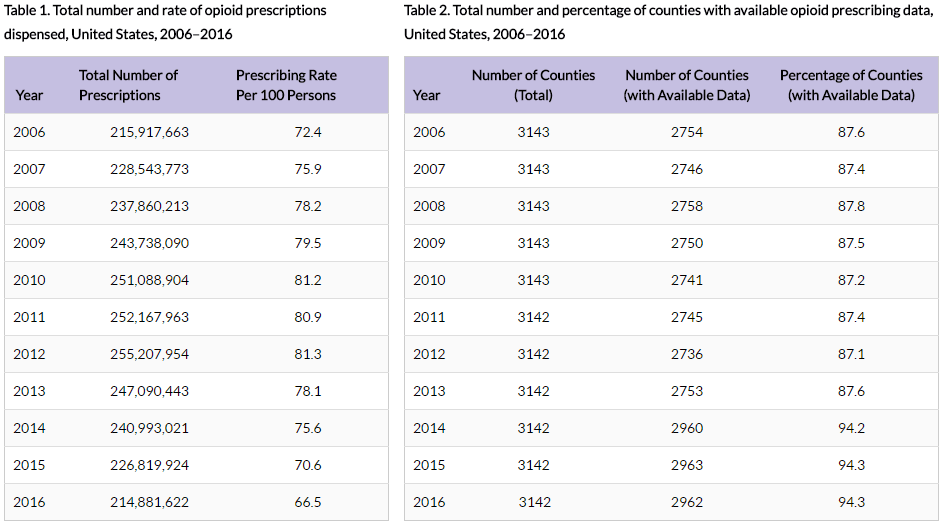
Effective Treatment for Opioid Addiction with Detox and Long-Term Rehab
The opioid crisis has affected the lives of countless Americans across the country. If you or a family member has personally experienced the devastating consequences of opioid abuse and addiction, you should know that there is still hope for recovery.
The first step in overcoming addiction is admitting you have a problem and seeking help. Finding a drug and alcohol detox center that provides individualized, round-the-clock care is a great way to get started.
The drug detox process is a vital part of the recovery process, as it will help you reach a stable and sober state so you can prepare for entry into an inpatient or outpatient rehab program. A high-quality detox program will also provide educated staff members who will provide recommendations for ongoing treatment based on your personal needs and circumstances.
Regardless of your substance abuse history, your current use, or how many times you’ve relapsed, the compassionate and experienced staff at Briarwood Detox Center is here to help. Call today to speak to an admissions specialist or to enroll yourself or a loved one in treatment.

